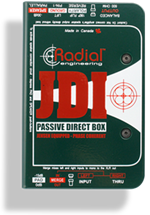We're often asked what the difference is between direct boxes, and this is a great question. So, let’s have a look at three different models from Radial, and explore what makes a JDI a JDI, and what makes a Stagebug a Stagebug. For this comparison we will look at passive DIs, starting with the Stagebug SB-2, continuing to the Pro DI, and finally we will have a look at the DI that changed the game -- the JDI.

In each of their direct boxes Radial features a transformer that is designed specifically for the job. The transformer in the Radial SB-2 is designed to be compact and offers amazing performance in a small package. In addition, the SB-2 offers a ground lift, as well as a pad to help with extreme signal levels. This enables this compact DI to handle nearly anything you throw at it. Finally, the SB-2 gives you a Thru to send your signal on to an amplifier or any other instrument level input. All of these features are housed in a rugged metal chassis that can handle the rigors of the road, all at $69.99.

The next step up from the SB-2 is the Radial Pro DI.
The Pro DI is an amazing direct box that you will find on stages and in studios the world over. So, what is the difference between the SB-2 and Pro DI? Well, the first difference is the transformer. In the Pro DI, the transformer offers additional shielding that helps prevent electromagnetic interference and is a bit larger than its little brother in the SB-2. Like the SB-2, the Pro DI features a ground lift, pad, and thru; giving you all the basic functions that are essential in a DI. All of this is housed in a near bullet-proof 14-gauge metal housing with I-beam construction. When you factor in all that the Pro DI offers at an incredibly competitive price of $99.99, it’s easy to see why it has gained the popularity it now sees.

The Radial JDI is arguably the most popular high end passive direct box on the planet. Trust me, you have heard its mojo on countless concert stages and in endless recordings. You just may not know it. This simply means it’s doing its job by staying true to the source. The JDI employs the legendary Jensen Transformer. Jensen transformers are known for their ability to gracefully handle transients while delivering a smooth, warm sounding Bessel curve, reminiscent of the finest vintage gear. Ruler flat from 10Hz to 40kHz with virtually zero phase deviation, the JDI delivers the natural, pure sound of the instrument without artifact -- which is why the JDI has become the DI that top level artists and engineers rely on every day.
There are also added features that make the JDI incredibly versatile. A secondary circuit is added for direct interfacing with high output devices such as guitar or bass amp loudspeakers, plus a unique merge function allows stereo sources such as keyboards to be summed to mono, saving valuable input channels. So, when you want the very best in passive DIs look no further than what top artists and engineers already know and trust, song after song and show after show…the Radial JDI! $199.99 each.
I hope this helps to clear up the common question of what the difference is between different Radial DIs, at least for passive DIs. If you have questions, please feel free to call us anytime.
